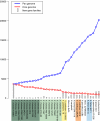On the origins of a Vibrio species
- PMID: 19830476
- PMCID: PMC2807590
- DOI: 10.1007/s00248-009-9596-7
On the origins of a Vibrio species
Abstract
Thirty-two genome sequences of various Vibrionaceae members are compared, with emphasis on what makes V. cholerae unique. As few as 1,000 gene families are conserved across all the Vibrionaceae genomes analysed; this fraction roughly doubles for gene families conserved within the species V. cholerae. Of these, approximately 200 gene families that cluster on various locations of the genome are not found in other sequenced Vibrionaceae; these are possibly unique to the V. cholerae species. By comparing gene family content of the analysed genomes, the relatedness to a particular species is identified for two unspeciated genomes. Conversely, two genomes presumably belonging to the same species have suspiciously dissimilar gene family content. We are able to identify a number of genes that are conserved in, and unique to, V. cholerae. Some of these genes may be crucial to the niche adaptation of this species.
Figures





References
-
- Bassler B et al. (2007) CP000789.1: Direct submission to GenBank
-
- Clayton RA, Sutton G, Hinkle PS, Bult C, Fields C. Intraspecific variation in small-subunit rRNA sequences in GenBank: why single sequences may not adequately represent prokaryotic taxa. Int J Syst Bacteriol. 1995;45:595–599. - PubMed
-
- Colwell R, Grim CJ, Young S, Jaffe D, Gnerre S, Berlin A, Heiman D, Hepburn T, Shea T, Sykes S, Alvarado L, Kodira C, Heidelberg J, Lander E, Galagan J, Nusbaum C, Birren B (2008) NZ_AAKF00000000: Direct submission to GenBank
Publication types
MeSH terms
Substances
LinkOut - more resources
Full Text Sources
Research Materials

